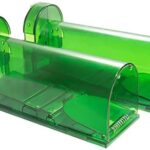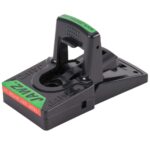Table of Contents
Our Top Pick!

Product Name: Press 'N Set Mouse Trap
Product Description: The Tomcat Press' N Set Trap is simple to use, unobtrusive and economical. This durable plastic trap can be baited and pressed relatively easily. It is equipped with a highly sensitive trigger and an integrated grab tab for easy removal. You may want to bait and place several traps at once to increase a mouse's chance of finding a way into one of them.
Availability: InStock
The right bait for the job at hand is one of the biggest frustrations in trying to trap rats. Often we hear people say that they have tried everything but had little luck in attracting rodents to a trap reliably. Unfortunately, it is true that it may take some trial and mistake to find the best bait for your particular situation. However, the good news is that these days, from scientifically developed formulations to everyday products, there are more options to rodent bait than ever before. Do you know the best bait for mouse and rat traps?
How Mousetraps Work
Traditional snap traps, also known as loaded-bar spring mousetraps, are widely used and commercially available. Snap traps are placed along with road rodents, and an attractive element like food or nesting material may be used. The metal bar snaps and kills the rodent when the spring mechanism is triggered.
Glue Traps
Glue traps are often placed in places similar to snap traps. After the trap is found, the mouse is immobilized with an adhesive surface. Trapped rodents expire from hypothermia because they can’t move and keep the temperature of your body.
Live-Catch Traps
Live-catch traps are also commercially available. This requires the householder to release the specimens into the natural environment without guaranteeing that the mouse does not return.
Live mousetraps are designed for homeowners who don’t want to kill a mouse. These traps also attract mice using food coats, when a metal door is closed, and the specimen is captured. Homeowners then have to throw the mice into the wild, and free mice often go back home.
It is important to note that house mice are not native to the United States and risk health and home but are highly destructive to indigenous birds and animals.
Regardless of type, mousetraps in the capture and extermination of individual rodents are considered to be very useful. However, it should be noted that mouse population growth is rapid and that more extreme pesticide control measures are often needed.
The Best Bait For Mouse And Rat Traps
Once you’ve found the trap that works best for you, try baiting and putting the trap right to maximize its use. Peanut butter and chocolate, cheese, and bird seeds or nuts are among the most effective and best bait for mouse and rat traps.
Mice have a great sense of smell, and although each bait has its own advantages and disadvantages, it’s important to choose a bait with a strong aroma if you want to trap mice effectively. Here are some of thee best bait for mouse and rat traps.
1. Chocolate Lures
One popular bait option is the lure of the chocolate formula. The tricks were designed to attract rats for a full month and are designed to remain stable in all weather conditions. This means that you don’t have to check your traps as frequently as most other options. In addition, they are a non-toxic option, meaning that pets and birds are safe.
Chocolate is an excellent rat lure in many environments, as it provides such an attractive, distinctive aroma. Rat not often find chocolate in rural and suburban lawns, so when they catch a whiff, they are drawn instinctively to it.
2. Peanut Butter
Peanut butter is one of the best baits for mouse and rat traps. It makes a simple rat lure that is already found in most people’s cabinet. A spreading scoop or dollop can be a very attractive bait because it produces an intriguing odor easily detected by rats. Another peanut butter advantage? It is also an option that is non-toxic.
3. DIY Lures
In some cases, your best bet is to use food the rats are already used to. Take into account where you have a rodent problem. Is there food for dogs, for animals, or birds? Do you have a compost basket or a vegetable garden, or do you leave food scraps regularly in readily accessible areas? All these could attract rats, so you can create attractions that you know will work.
You have the flexibility to use whatever lure you want with a DIY lure basket. If the rats close to your home fall in love with your pet’s meal, you can put it in the lure. Or add a little to the basket if they can’t resist your compost. You can even add chocolate or peanut butter to your lure to make it even more irresistible.
Appropriate Best Bait Ideas For Mouse And Rat Traps
Peanut butter is one of the most advanced rat appetizers to use because it appeals to the animal and is incredibly simple. You probably already have peanut butter in your house, and it will remain in place if you spread it on a trap.
Because the rat can’t just pick it up and carry the bait, they will be more likely to be trapped. While peanut butter is a popular choice, whole nuts, bacon, berries, gum, or dried fruits can also be used as an alternative for the best bait for mouse and rat traps. In general, roof rats will prefer plant-based foods, while Norway will prefer sugar, protein, and fat products. Both species like butter of peanut and dried fruit.
The Best Mouse And Rat Traps
Whether you’re having a full mouse infestation or just a few, here are 2020 ‘s best mouse traps.
| Product | Image | Rating |
|---|---|---|
| No Touch, No See Electronic Mouse Trap |  |  |
| Press 'N Set Mouse Trap |  |  |
| 2 Piece Humane Smart Mouse Trap |  |  |
| Jawz Plastic Mouse Trap |  |  |
No Touch, No See Electronic Mouse Trap
This Victor model is technologically designed to feel when a mouse enters the chamber. It produces a high voltage shock that quickly kills the mouse. We like the Victor electronic mouse trap, both without touch or disposal, and easy to empty, clean, and bait. The trap uses 4 AA batteries, and the company claims that it can kill up to 100 mice per battery set.
Press ‘N Set Mouse Trap
The Tomcat Press’ N Set Trap is simple to use, unobtrusive and economical. This durable plastic trap can be baited and pressed relatively easily. It is equipped with a highly sensitive trigger and an integrated grab tab for easy removal. You may want to bait and place several traps at once to increase a mouse’s chance of finding a way into one of them.
2 Piece Humane Smart Mouse Trap
This live catch and release trap pack comes with two units and is a cheap, reusable alternative that does not kill the mouse. The Catcha model has a spring door that closes when the mouse is inside the chamber and will not open until it is released. This trap can be easily baited, cleaned, and reset.
Jawz Plastic Mouse Trap
This JT Eaton model is available in 24 units, making it a good value for a snap trap. The trap has a high voltage spring, can be fitted by hand or foot, and has a limited 1-year warranty. We love to have a red label on the snap trap to indicate if it is set correctly, and it’s small enough to fit in small spaces. This model is ideal for installations or walls.
Use Many Traps
The best rule to use a rat trap is to use a lot of traps. You may need more traps than when trapping rats, you think. The population of rats is usually larger than expected. Make sure you catch rats, not mice. There is not enough a typical mouse trap to catch rats. Review these guidelines for identification. Use uncooked butter, seeds or nuts, bananas, apples, ice-cream, and raw meat, such as bacon or hot-dogs or raw chicken.
We have several professional lures that combine food with no peanuts. The rat will demonstrate adverse trap behavior because rats naturally suspect new objects and environments. Pre-load the traps without placing the traps to encourage the rats to go to the traps.
The Correct Trap Placing
Place rat traps in the rat colony’s highly active areas. These areas may include darkened corners, walls, appliances and objects, and all areas in which drops are visible. As rats have to touch surfaces as they move, they must be placed accordingly. Rat traps spaced between 15-20 feet apart. Remember to put them on a wall because rats run along walls to prevent detection.
More Than Bait
Using the correct bait can help your rat trapping, but it will still be unnecessary if you have not selected and correctly tossed the right types of traps. You should always choose snap traps because they are very efficient; they will immediately kill the rats and make them a humane method.
Caution traps are inhumane, not useful, and live cage traps require you to move the rat because these rodents remain in a small area. The death penalty is sure. You also have to use enough in addition to placing the traps correctly. Start with at least a dozen traps, as rats are social animals.
Concentrate On Location
Even if you skip the bait but place the rat trap at the right place, experts will tell you that you will succeed. On the other hand, it is unlikely that the best bait and an unfortunate trap will lead to results. This means checking the shelter and looking for the paths of the rats.
These rodents repeatedly pass along the same paths, and you can recognize them typically with their grate and droppings. Place traps along these tracks, and you don’t have to wear bait. Put peanut butter or dried fruit in a trap if it makes you feel better and wait for it to work.
Signs of Rat Infestation
As nocturnal, rats are most active between dawn and dusk and usually hide from people throughout the day. It is often easier to identify signs of a problem than the actual pest.
Rat Droppings
Concentrated areas are usually found, as rats produce up to 40 droppings per night. Brown rat droppings are dark brown in a tapered, 9mm-14 mm spindle form. They can look like a big grain of rice.
Noise
Black rats are agile climbers and can easily access loft areas and buildings on the upper floors. Hearing scratching noises from above at night could indicate their presence.
Brown rats are less skilled climbers, on the other hand. You can hear them rattling under decks, sheds, and floorboards. They are more likely to be identified with a grinding noise, known as bruxing, with their teeth.
Footprints
A rat leaves foot and tail marks in dusty, less-used building areas. A strong, low-angle torch should reveal tracks clearly. Sprinkle fine flour or talc over a little stretch of the floor near the footprints to establish if an infestation is active and check for fresh tracks the following day.
Rub Marks
Rats use established routes along with skirts and walls because of their poor vision. Grease and dirt leave dark marks on both objects and surfaces against which they regularly brush on their bodies. These marks may indicate rodent activity, but since rodents are not a good measure for an active infestation for a long period.
Damage
Rat has teeth that are continually growing. You must rub wood and plastic to keep them secure. They can cause fires through the use of electrical cables. You can also see ripped food packaging, as rats tear open food, leaving visible markers on teeth.
Nests
Rats build nests with shredded materials like newspaper and fabrics in warm, hidden spots. Nests are often found near a food source and contain young rats—Check-in and outside of your kitchen appliances such as fridges and freezers.
Burrows
Brown rats are known for digging and digging large burrow systems for shelter, food storage, and nesting. Look for burrows in heaps of compost, deck, garden sheds, or garages.
Final Words
Recall that trapping rats take a little time — especially to determine what will attract them to the trap. Learn a little about the types of rats common in your region and set bait that suits their diet. Meanwhile, remove other possible food sources. You’ll begin to see a bit of patience and know that you’ve found the best bait for your situation.





